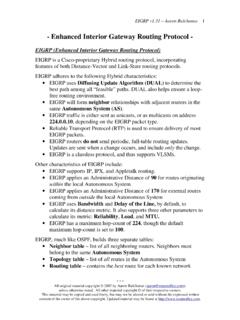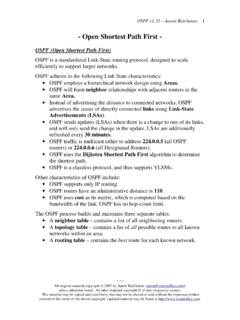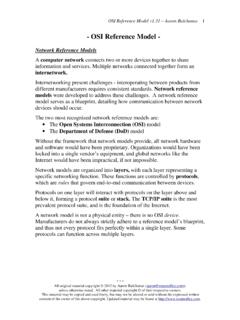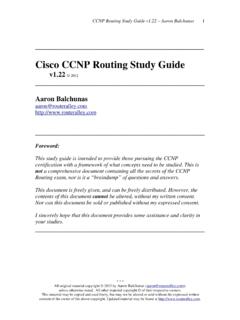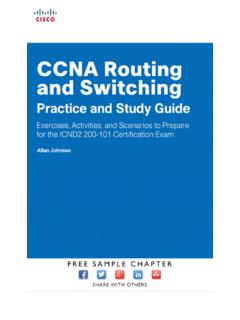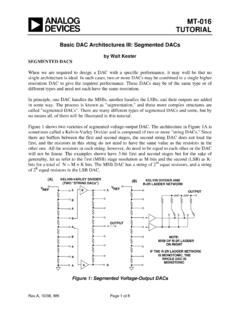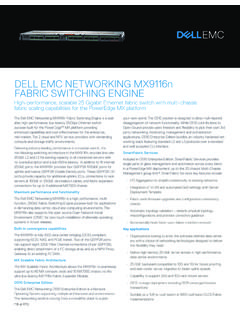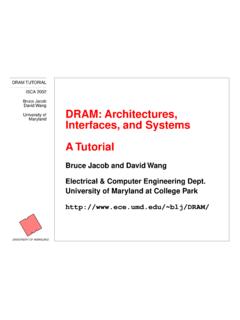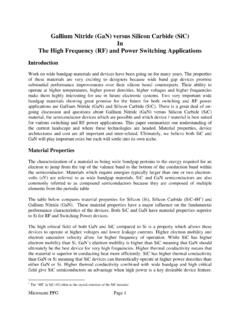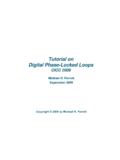Transcription of ccnp switching studyguide - Router Alley
1 ccnp switching Study Guide Aaron Balchunas * * * All original material copyright 2014 by Aaron Balchunas unless otherwise noted. All other material copyright of their respective owners. This material may be copied and used freely, but may not be altered or sold without the expressed written consent of the owner of the above copyright. Updated material may be found at 1 _____ Cisco ccnp switching Study Guide 2014 _____ Aaron Balchunas _____ Foreword: This study guide is intended to provide those pursuing the CCNP certification with a framework of what concepts need to be studied. This is not a comprehensive document containing all the secrets of the ccnp switching exam, nor is it a braindump of questions and answers.
2 This document is freely given, and can be freely distributed. However, the contents of this document cannot be altered, without my written consent. Nor can this document be sold or published without my expressed consent. I sincerely hope that this document provides some assistance and clarity in your studies. _____ ccnp switching Study Guide Aaron Balchunas * * * All original material copyright 2014 by Aaron Balchunas unless otherwise noted. All other material copyright of their respective owners. This material may be copied and used freely, but may not be altered or sold without the expressed written consent of the owner of the above copyright.
3 Updated material may be found at 2 Table of Contents Part I General switching Concepts Section 1 Ethernet Technologies Section 2 Hubs vs. Switches vs. Routers Section 3 switching Architectures Section 4 switching Tables Part II Switch Configuration Section 5 The Cisco IOS Section 6 Switch Port Configuration Part III switching Protocols and Functions Section 7 VLANs and VTP Section 8 EtherChannel Section 9 Spanning-Tree Protocol Section 10 Multilayer switching Section 11 SPAN Part IV Advanced Switch Services Section 12 Redundancy and Load Balancing Part V Switch Security Section 13 Switch Port and VLAN Security Part VI QoS Section 14 Introduction to Quality of Service Section 15 QoS
4 Classification and Marking Section 16 QoS Queuing Section 17 QoS Congestion Avoidance ccnp switching Study Guide Aaron Balchunas * * * All original material copyright 2014 by Aaron Balchunas unless otherwise noted. All other material copyright of their respective owners. This material may be copied and used freely, but may not be altered or sold without the expressed written consent of the owner of the above copyright. Updated material may be found at 3 _____ Part I General switching Concepts _____ ccnp switching Study Guide Aaron Balchunas * * * All original material copyright 2014 by Aaron Balchunas unless otherwise noted.
5 All other material copyright of their respective owners. This material may be copied and used freely, but may not be altered or sold without the expressed written consent of the owner of the above copyright. Updated material may be found at 4 Section 1 - Ethernet Technologies - What is Ethernet? Ethernet is a family of technologies that provides data-link and physical specifications for controlling access to a shared network medium. It has emerged as the dominant technology used in LAN networking. Ethernet was originally developed by Xerox in the 1970s, and operated at The technology was standardized as Ethernet Version 1 by a consortium of three companies - DEC, Intel, and Xerox, collectively referred to as DIX - and further refined as Ethernet II in 1982.
6 In the mid 1980s, the Institute of Electrical and Electronic Engineers (IEEE) published a formal standard for Ethernet, defined as the IEEE standard. The original Ethernet operated at 10 Mbps, and successfully supplanted competing LAN technologies, such as Token Ring. Ethernet has several benefits over other LAN technologies: Simple to install and manage Inexpensive Flexible and scalable Easy to interoperate between vendors (References: ; ) Ethernet Cabling Types Ethernet can be deployed over three types of cabling: Coaxial cabling almost entirely deprecated in Ethernet networking Twisted-pair cabling Fiber optic cabling Coaxial cable, often abbreviated as coax, consists of a single wire surrounded by insulation, a metallic shield, and a plastic sheath.
7 The shield helps protect against electromagnetic interference (EMI), which can cause attenuation, a reduction of the strength and quality of a signal. EMI can be generated by a variety of sources, such as florescent light ballasts, microwaves, cell phones, and radio transmitters. Coax is commonly used to deploy cable television to homes and businesses. ccnp switching Study Guide Aaron Balchunas * * * All original material copyright 2014 by Aaron Balchunas unless otherwise noted. All other material copyright of their respective owners. This material may be copied and used freely, but may not be altered or sold without the expressed written consent of the owner of the above copyright.
8 Updated material may be found at 5 Ethernet Cabling Types (continued) Two types of coax were used historically in Ethernet networks: Thinnet Thicknet Thicknet has a wider diameter and more shielding, which supports greater distances. However, it is less flexible than the smaller thinnet, and thus more difficult to work with. A vampire tap is used to physically connect devices to thicknet, while a BNC connector is used for thinnet. Twisted-pair cable consists of two or four pairs of copper wires in a plastic sheath. Wires in a pair twist around each other to reduce crosstalk, a form of EMI that occurs when the signal from one wire bleeds or interferes with a signal on another wire.
9 Twisted-pair is the most common Ethernet cable. Twisted-pair cabling can be either shielded or unshielded. Shielded twisted-pair is more resistant to external EMI; however, all forms of twisted-pair suffer from greater signal attenuation than coax cable. There are several categories of twisted-pair cable, identified by the number of twists per inch of the copper pairs: Category 3 or Cat3 - three twists per inch. Cat5 - five twists per inch. Cat5e - five twists per inch; pairs are also twisted around each other. Cat6 six twists per inch, with improved insulation. An RJ45 connector is used to connect a device to a twisted-pair cable.
10 The layout of the wires in the connector dictates the function of the cable. While coax and twisted-pair cabling carry electronic signals, fiber optics uses light to transmit a signal. Ethernet supports two fiber specifications: Singlemode fiber consists of a very small glass core, allowing only a single ray or mode of light to travel across it. This greatly reduces the attenuation and dispersion of the light signal, supporting high bandwidth over very long distances, often measured in kilometers. Multimode fiber consists of a larger core, allowing multiple modes of light to traverse it. Multimode suffers from greater dispersion than singlemode, resulting in shorter supported distances.


